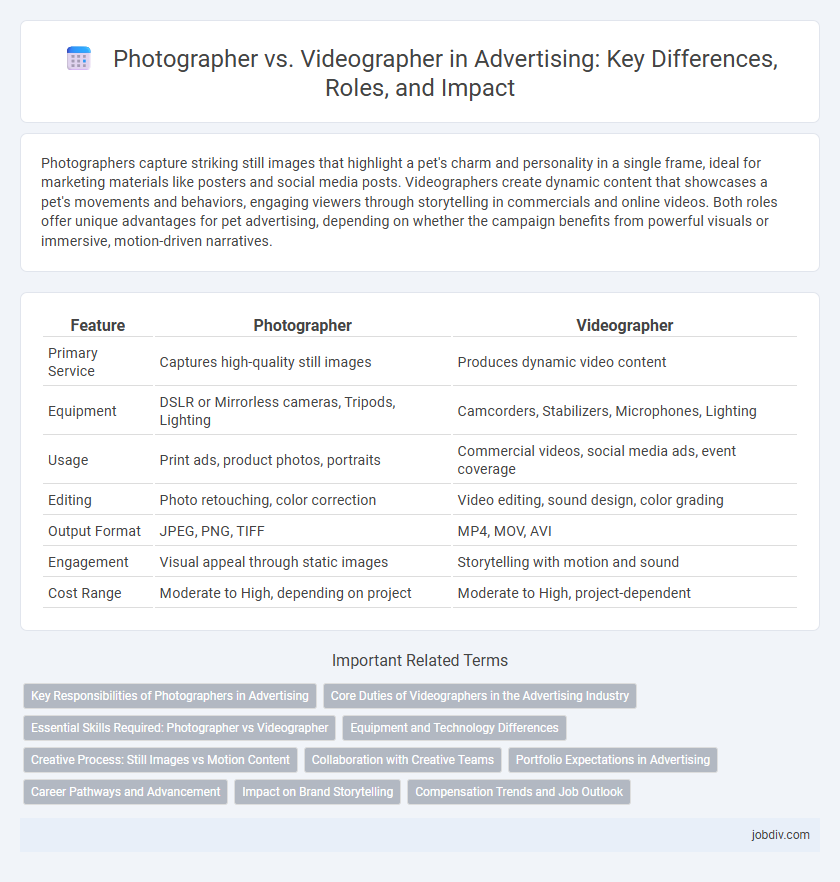Photographers capture striking still images that highlight a pet's charm and personality in a single frame, ideal for marketing materials like posters and social media posts. Videographers create dynamic content that showcases a pet's movements and behaviors, engaging viewers through storytelling in commercials and online videos. Both roles offer unique advantages for pet advertising, depending on whether the campaign benefits from powerful visuals or immersive, motion-driven narratives.
Table of Comparison
| Feature | Photographer | Videographer |
|---|---|---|
| Primary Service | Captures high-quality still images | Produces dynamic video content |
| Equipment | DSLR or Mirrorless cameras, Tripods, Lighting | Camcorders, Stabilizers, Microphones, Lighting |
| Usage | Print ads, product photos, portraits | Commercial videos, social media ads, event coverage |
| Editing | Photo retouching, color correction | Video editing, sound design, color grading |
| Output Format | JPEG, PNG, TIFF | MP4, MOV, AVI |
| Engagement | Visual appeal through static images | Storytelling with motion and sound |
| Cost Range | Moderate to High, depending on project | Moderate to High, project-dependent |
Key Responsibilities of Photographers in Advertising
Photographers in advertising are responsible for creating high-quality, visually compelling images that effectively convey a brand's message and appeal to its target audience. They collaborate closely with art directors and marketing teams to conceptualize and execute photo shoots, ensuring alignment with campaign goals and brand identity. Their expertise in lighting, composition, and editing enhances product presentation, driving consumer engagement and increasing campaign impact.
Core Duties of Videographers in the Advertising Industry
Videographers in the advertising industry specialize in capturing moving images that convey brand messages effectively across multiple platforms, including television, social media, and web content. Their core duties involve planning shot sequences, managing lighting and sound for video shoots, and editing footage to produce engaging commercials and promotional content. They collaborate closely with creative teams to ensure visual storytelling aligns with marketing objectives and brand identity.
Essential Skills Required: Photographer vs Videographer
Photographers require expertise in composition, lighting, and post-processing to capture still images that convey emotion and story. Videographers must master camera movement, audio recording, and video editing software to create engaging, dynamic narratives. Both skills demand a strong understanding of visual storytelling and technical proficiency with equipment.
Equipment and Technology Differences
Photographers primarily use DSLR or mirrorless cameras with high-resolution sensors and specialized lenses to capture still images, emphasizing aspects like aperture and shutter speed for image clarity. Videographers rely on camcorders or cinema cameras equipped with advanced stabilization gear, microphones, and lighting setups to create smooth, high-quality motion footage. The integration of editing software varies as photographers focus on photo enhancement tools, while videographers utilize complex video editing suites for sequencing, color grading, and sound design.
Creative Process: Still Images vs Motion Content
Photographers capture single moments with precise composition, lighting, and emotion to create compelling still images that tell a story instantly. Videographers produce motion content by combining sequence, audio, and visual effects, enabling dynamic storytelling over time. Both professions require creative vision, but photographers emphasize capturing the perfect frozen frame while videographers focus on continuous narrative flow.
Collaboration with Creative Teams
Photographers and videographers bring unique skills that enhance collaboration within creative advertising teams by blending still imagery with dynamic motion content. Effective teamwork leverages photographers' expertise in framing and lighting alongside videographers' ability to capture narrative flow and sound, resulting in cohesive campaigns. Integrating both disciplines ensures diverse visual storytelling that maximizes audience engagement and brand impact.
Portfolio Expectations in Advertising
Photographers in advertising are expected to deliver high-resolution, visually striking images that capture brand aesthetics with precise composition and lighting. Videographers must produce dynamic video content featuring smooth transitions, compelling storytelling, and synchronized audio to engage viewers effectively. Both portfolios should showcase versatility across diverse campaigns, highlighting creativity tailored to target audiences and brand messaging.
Career Pathways and Advancement
Photographers build expertise in visual storytelling through still images, specializing in fields like fashion, commercial, or portrait photography, often advancing by developing a unique portfolio and securing agency representation. Videographers focus on motion visuals, mastering skills in filming, editing, and direction, with career progression linked to gaining experience in film production, corporate video, or event coverage, and expanding technical proficiencies in software like Adobe Premiere or Final Cut Pro. Both careers offer pathways toward freelancing, studio ownership, or creative directorship, with continuous learning and networking playing crucial roles in advancement.
Impact on Brand Storytelling
Photographers capture powerful still images that create immediate emotional connections and visually define a brand's identity in advertising. Videographers produce dynamic, multi-sensory content through motion and sound, enhancing narrative depth and audience engagement over time. Both mediums significantly impact brand storytelling by shaping perception, but video often drives stronger emotional resonance and memorability in campaigns.
Compensation Trends and Job Outlook
Photographers and videographers experience differing compensation trends, with videographers generally commanding higher salaries due to increased demand for video content in digital advertising. The job outlook for videographers is projected to grow faster than that of photographers, driven by expanding online video platforms and marketing campaigns. Brands allocate more budget toward video production, enhancing opportunities and wage potential for skilled videographers in the advertising industry.
Photographer vs Videographer Infographic

 jobdiv.com
jobdiv.com